Physical Experiment and Numerical Modeling on the Failure Mechanism of Gob-Side Entry Driven in Thick Coal Seam
Abstract
1. Introduction
2. Case Study
2.1. Engineering Geological Conditions
2.2. In-Situ Observation of the Deformation and Failure Characteristics of the Roadway
3. Physical Simulation Experiment
3.1. Introduction of the Physical Model Test System
3.2. Determination of the Similarity Material Ratio
3.3. Physical Model Experiment Results Analysis
3.3.1. Overlying Strata Movement Evolution
3.3.2. Stress and Deformation Analysis of Gob-Side Entry
4. Numerical Simulation Using UDEC
4.1. The UDEC Trigon Approach
4.2. Calibration of the Simulation Parameters
4.3. Model Configuration
4.4. Numerical Modeling Results Analysis
4.4.1. Failure Characteristics and Crack Evolution
4.4.2. Damage Analysis of the Coal Pillar
4.4.3. Deformation and Displacement Analysis of the Roadway
5. Discussion
6. Conclusions
Author Contributions
Funding
Acknowledgments
Conflicts of Interest
References
- Yang, J.; He, M.C.; Cao, C. Design principles and key technologies of gob side entry retaining by roof pre-fracturing. Tunn. Undergr. Space Technol. 2019, 90, 309–318. [Google Scholar] [CrossRef]
- Zhang, N.; Yuan, L.; Han, C.L.; Xue, J.H.; Kan, J.G. Stability and deformation of surrounding rock in pillarless gob-side entry retaining. Saf. Sci. 2012, 50, 593–599. [Google Scholar] [CrossRef]
- Bai, J.B.; Shen, W.L.; Guo, G.L.; Wang, X.Y.; Yu, Y. Roof deformation, failure characteristics, and preventive techniques of gob-side entry driving heading adjacent to the advancing working face. Rock Mech. Rock Eng. 2015, 48, 2447–2458. [Google Scholar] [CrossRef]
- Ma, D.; Duan, H.Y.; Liu, J.F.; Li, X.B.; Zhou, Z.L. The role of gangue on the mitigation of mining-induced hazards and environmental pollution: An experimental investigation. Sci. Total Environ. 2019, 664, 436–448. [Google Scholar] [CrossRef]
- Zhang, Y.; Wan, Z.J.; Li, F.C.; Zhou, C.B.; Zhang, B.; Guo, F.; Zhu, C.T. Stability of coal pillar in gob-side entry driving under unstable overlying strata and its coupling support control technique. Int. J. Min. Sci. Technol. 2013, 23, 193–199. [Google Scholar] [CrossRef]
- Yang, J.P.; Cao, S.G.; Li, X.H. Failure laws of narrow pillar and asymmetric control technique of gob-side entry driving in island coal face. Int. J. Min. Sci. Technol. 2013, 23, 267–272. [Google Scholar] [CrossRef]
- Zha, W.H.; Shi, H.; Liu, S.; Kang, C.H. Surrounding rock control of gob-side entry driving with narrow coal pillar and roadway side sealing technology in Yangliu Coal Mine. Int. J. Min. Sci. Technol. 2017, 27, 819–823. [Google Scholar] [CrossRef]
- He, M.C.; Gao, Y.B.; Yang, J.; Gong, W.L. An innovative approach for gob-side entry retaining in thick coal seam longwall mining. Energies. 2017, 10, 1785. [Google Scholar] [CrossRef]
- Ju, J.F.; Xu, J.L. Structural characteristics of key strata and strata behaviour of a fully mechanized longwall face with 7.0 m height chocks. Int. J. Rock Mech. Min. Sci. 2013, 58, 46–54. [Google Scholar] [CrossRef]
- Wang, J.; Ning, J.G.; Jiang, L.S.; Jiang, J.Q.; Bu, T.T. Structural characteristics of strata overlying of a fully mechanized longwall face: A case study. J. South. Afr. Inst. Min. Metall. 2018, 118, 1195–1204. [Google Scholar] [CrossRef]
- Huang, Y.L.; Zhang, J.X.; An, B.F.; Zhang, Q. Overlying strata movement law in fully mechanized coal mining and backfilling longwall face by similar physical simulation. J. Min. Sci. 2011, 47, 618–627. [Google Scholar]
- Zhang, S.; Wang, X.F.; Fan, G.W.; Zhang, D.S.; Cui, J.B. Pillar size optimization design of isolated island panel gob-side entry driving in deep inclined coal seam—Case study of Pingmei No. 6 coal seam. J. Geophys. Eng. 2018, 15, 816–828. [Google Scholar] [CrossRef]
- Ma, D.; Duan, H.Y.; Li, X.B.; Li, Z.H.; Zhou, Z.L.; Li, T.B. Effects of seepage-induced erosion on nonlinear hydraulic properties of broken red sandstones. Tunn. Undergr. Space Technol. 2019, 91, 102993. [Google Scholar] [CrossRef]
- Huang, Y.L.; Li, J.M.; Song, T.Q.; Kong, G.Q.; Li, M. Analysis on filling ratio and shield supporting pressure for overburden movement control in coal mining with compacted backfilling. Energies 2017, 10, 31. [Google Scholar] [CrossRef]
- Ma, X.G.; He, M.C.; Wang, J.; Gao, Y.B.; Zhu, D.Y.; Liu, Y.X. Mine strata pressure characteristics and mechanisms in gob-side entry retention by roof cutting under medium-thick coal seam and compound roof conditions. Energies 2018, 11, 2539. [Google Scholar] [CrossRef]
- Wang, X.; Yuan, W.; Yan, Y.T.; Zhang, X. Scale effect of mechanical properties of jointed rock mass: A numerical study based on particle flow code. Geomech. Eng. 2020, 21, 259–268. [Google Scholar]
- Wang, J.; Ning, J.G.; Qiu, P.Q.; Yang, S.; Shang, H.F. Microseismic monitoring and its precursory parameter of hard roof collapse in longwall faces: A case study. Geomech. Eng. 2019, 17, 375–383. [Google Scholar]
- Tian, M.L.; Han, L.J.; Meng, Q.B.; Ma, C.; Zong, Y.J.; Mao, P.Q. Physical Model Experiment of Surrounding Rock Failure Mechanism for the Roadway under Deviatoric Pressure form Mining Disturbance. KSCE J. Civ. Eng. 2020, 24, 1103–1115. [Google Scholar] [CrossRef]
- Sun, X.M.; Chen, F.; He, M.C.; Gong, W.L.; Xu, H.C.; Lu, H. Physical modeling of floor heave for the deep-buried roadway excavated in ten degree inclined strata using infrared thermal imaging technology. Tunn. Undergr. Space Technol. 2017, 63, 228–243. [Google Scholar] [CrossRef]
- Yang, X.X.; Sun, D.K.; Jing, H.W. Morphological features of shear-formed fractures developed in a rock bridge. Eng. Geol. 2020, 278, 105833. [Google Scholar] [CrossRef]
- He, M.C. Physical modeling of an underground roadway excavation in geologically 45 inclined rock using infrared thermography. Eng. Geol. 2011, 121, 165–176. [Google Scholar] [CrossRef]
- Yang, S.Q.; Chen, M.; Fang, G.; Wang, Y.C.; Meng, B.; Li, Y.H.; Jing, H.W. Physical experiment and numerical modelling of tunnel excavation in slanted upper-soft and lower-hard strata. Tunn. Undergr. Space Technol. 2018, 82, 248–264. [Google Scholar] [CrossRef]
- Han, C.L.; Zhang, N.; Xue, J.H.; Kan, J.G.; Zhao, Y.M. Multiple and long-term disturbance of gob-side entry retaining by grouped roof collapse and an innovative adaptive technology. Rock Mech. Rock Eng. 2019, 52, 2761–2773. [Google Scholar] [CrossRef]
- Li, S.C.; Wang, Q.; Wang, H.T.; Jiang, B.; Wang, D.C.; Zhang, B.; Li, Y.; Ruan, G.Q. Model test study on surrounding rock deformation and failure mechanisms of deep roadways with thick top coal. Tunn. Undergr. Space Technol. 2015, 47, 52–63. [Google Scholar] [CrossRef]
- Kang, H.P.; Lou, J.F.; Gao, F.Q.; Yang, J.H.; Li, J.Z. A physical and numerical investigation of sudden massive roof collapse during longwall coal retreat mining. Int. J. Coal Geol. 2018, 188, 25–36. [Google Scholar] [CrossRef]
- Xue, J.H.; Wang, H.P.; Zhou, W.; Ren, B.; Duan, C.R.; Deng, D.S. Experimental research on overlying strata movement and fracture evolution in pillarless stress-relief mining. Int. J. Coal Sci. Technol. 2015, 2, 38–45. [Google Scholar] [CrossRef]
- Pellet, F.; Roosefid, M.; Deleruyelle, F. On the 3D numerical modelling of the time-dependent development of the damage zone around underground galleries during and after excavation. Tunn. Undergr. Space Technol. 2009, 24, 665–674. [Google Scholar] [CrossRef]
- Coggan, J.; Gao, F.Q.; Stead, D.; Elmo, D. Numerical Modelling of the Effects of Weak Immediate Roof Lithology on Coal Mine Roadway Stability. Int. J. Coal Geol. 2012, 90, 100–109. [Google Scholar] [CrossRef]
- Weng, L.; Huang, L.Q.; Taheri, A.; Li, X.B. Rockburst characteristics and numerical simulation based on a strain energy density index: A case study of a roadway in Linglong gold mine, China. Tunn. Undergr. Space Technol. 2017, 69, 223–232. [Google Scholar] [CrossRef]
- Mo, S.; Sheffield, P.; Corbett, P.; Ramandi, H.L.; Oh, J.; Canbulat, I.; Saydam, S. A numerical investigation into floor buckling mechanisms in underground coal mine roadways. Tunn. Undergr. Space Technol. 2020, 103, 103497. [Google Scholar] [CrossRef]
- Małkowski, P. The impact of the physical model selection and rock mass stratification on the results of numerical calculations of the state of rock mass deformation around the roadways. Tunn. Undergr. Space Technol. 2015, 50, 365–375. [Google Scholar] [CrossRef]
- Fan, D.Y.; Liu, X.S.; Tan, Y.L.; Song, S.L.; Gu, Q.H.; Yan, L.; Xu, Q. Roof cutting parameters design for gob-side entry in deep coal mine: A case study. Energies 2019, 12, 2032. [Google Scholar] [CrossRef]
- Gao, F.Q.; Stead, D.; Kang, H.P.; Wu, Y.Z. Discrete element modelling of deformation and damage of a roadway driven along an unstable goaf—A case study. Int. J. Coal Geol. 2014, 127, 100–110. [Google Scholar] [CrossRef]
- Wang, B.; Hao, J.L.; Liu, S.D.; Zhou, F.B.; Zhang, Z.L.; Zhang, H.; Sun, H.C. Experimental study on the effect of gas pressure on ultrasonic velocity and anisotropy of anthracite. Geofluids 2019, 2019, 1–10. [Google Scholar] [CrossRef]
- Huang, B.X.; Liu, J.W.; Zhang, Q. The reasonable breaking location of overhanging hard roof for directional hydraulic fracturing to control strong strata behaviors of gob-side entry. Int. J. Rock Mech. Min. Sci. 2018, 103, 1–11. [Google Scholar] [CrossRef]
- Ma, S.Q.; Chen, Y. Application of hydraulic fracturing and energy-absorption rockbolts to improve the stability of a gob-side roadway in a 10-m-thick coal seam: Case study. Int. J. Geomech. 2017, 17, 05017002. [Google Scholar] [CrossRef]
- Yin, D.W.; Meng, X.X.; Zhang, Z.Y.; Liu, B.C. Gob-side entry retaining formed by roof cutting without roadside support. Int. J. Oil Gas Coal Technol. 2018, 18, 467–484. [Google Scholar] [CrossRef]
- Huang, W.P.; Wang, X.; Shen, Y.; Feng, F.; Wu, K.; Li, C. Application of concrete-filled steel tubular columns in gob-side entry retaining under thick and hard roof stratum: A case study. Energy Sci. Eng. 2019, 7, 2540–2553. [Google Scholar] [CrossRef]
- Hu, J.Z.; He, M.C.; Wang, J.; Ma, Z.M.; Wang, Y.J.; Zhang, X.Y. Key parameters of roof cutting of gob-side entry retaining in a deep inclined thick coal seam with hard roof. Energies 2019, 12, 934. [Google Scholar] [CrossRef]
- Zhang, Y.C.; Jiang, Y.; Asahina, D.; Wang, C.S. Experimental and Numerical Investigation on Shear Failure Behavior of Rock-like Samples Containing Multiple Non-Persistent Joints. Rock Mech. Rock Eng. 2020, 1–28. [Google Scholar] [CrossRef]
- Zang, C.W.; Chen, M.; Zhang, G.C.; Wang, K.; Gu, D.D. Research on the failure process and stability control technology in a deep roadway: Numerical simulation and field test. Energy Sci. Eng. 2020, 8, 2297–2310. [Google Scholar] [CrossRef]
- Wu, B.W.; Wang, X.Y.; Bai, J.B.; Wu, W.D.; Zhu, X.X.; Li, G.D. Study on crack evolution mechanism of roadside backfill body in gob-side entry retaining based on UDEC trigon model. Rock Mech. Rock Eng. 2019, 52, 3385–3399. [Google Scholar] [CrossRef]
- Zhang, L.Y.; Einstein, H.H. Using RQD to estimate the deformation modulus of rock masses. Int. J. Rock Mech. Min. Sci. 2004, 41, 337–341. [Google Scholar] [CrossRef]
- Singh, M.; Rao, K.S. Empirical methods to estimate the strength of jointed rock masses. Eng. Geol. 2005, 77, 127–137. [Google Scholar] [CrossRef]
- Itasca Consulting Group, Inc. UDEC User Manual; Itasca Consulting Group, Inc.: Minneapolis, MN, USA, 2008. [Google Scholar]
- Gao, F.Q.; Stead, D.; Kang, H.P. Numerical simulation of squeezing failure in a coal mine roadway due to mining-induced stresses. Rock Mech. Rock Eng. 2015, 48, 1635–1645. [Google Scholar] [CrossRef]
Publisher’s Note: MDPI stays neutral with regard to jurisdictional claims in published maps and institutional affiliations. |
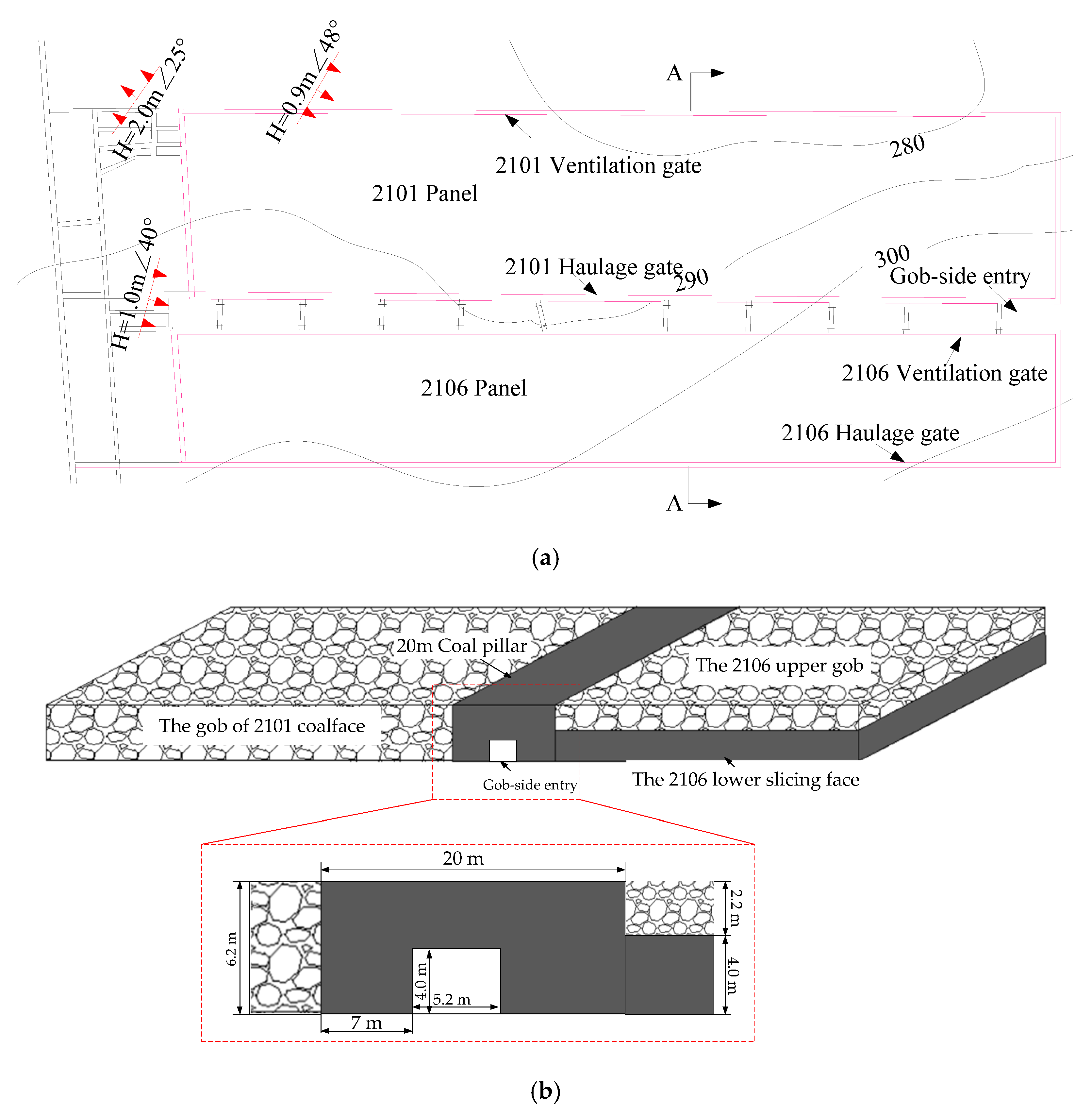
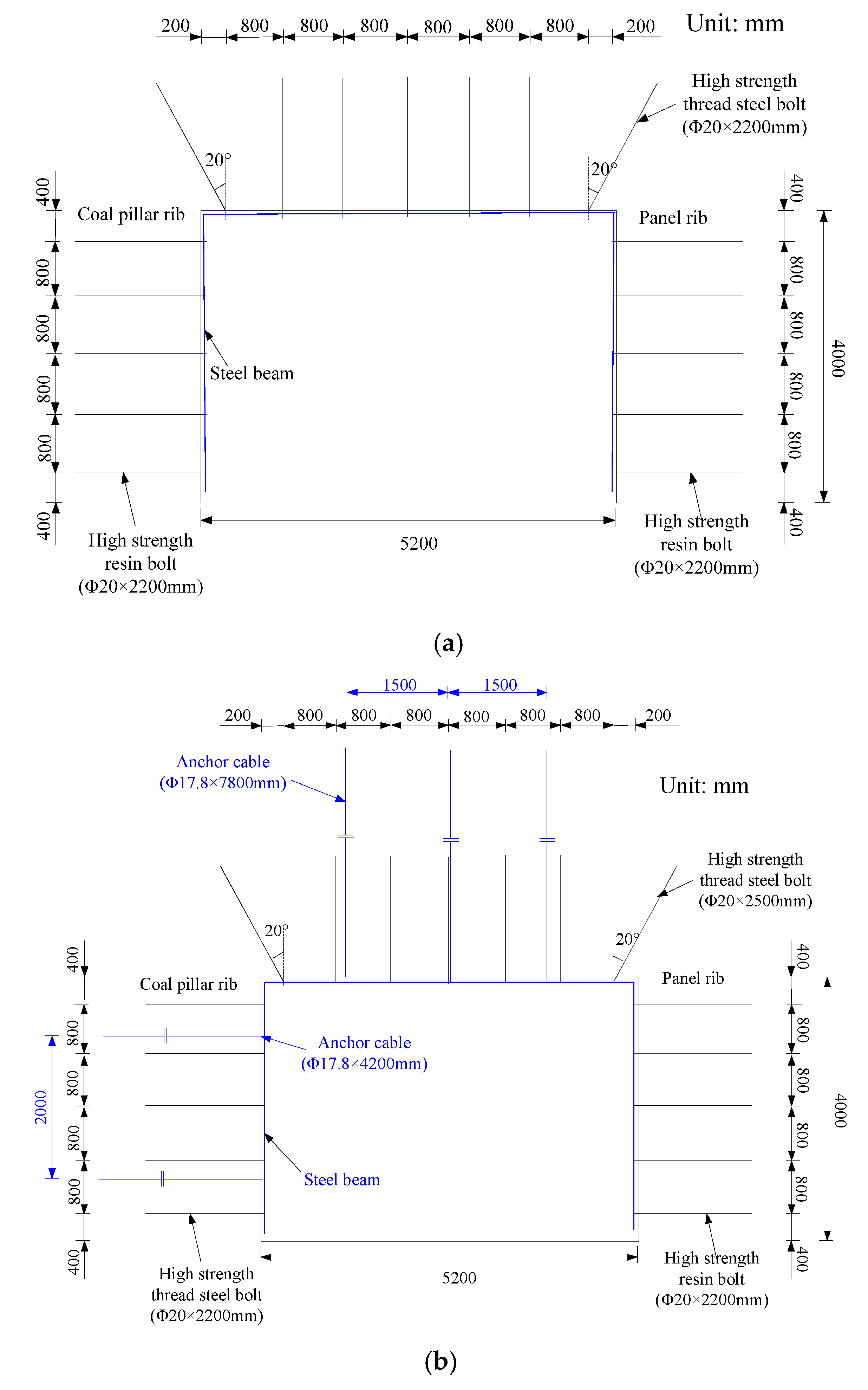

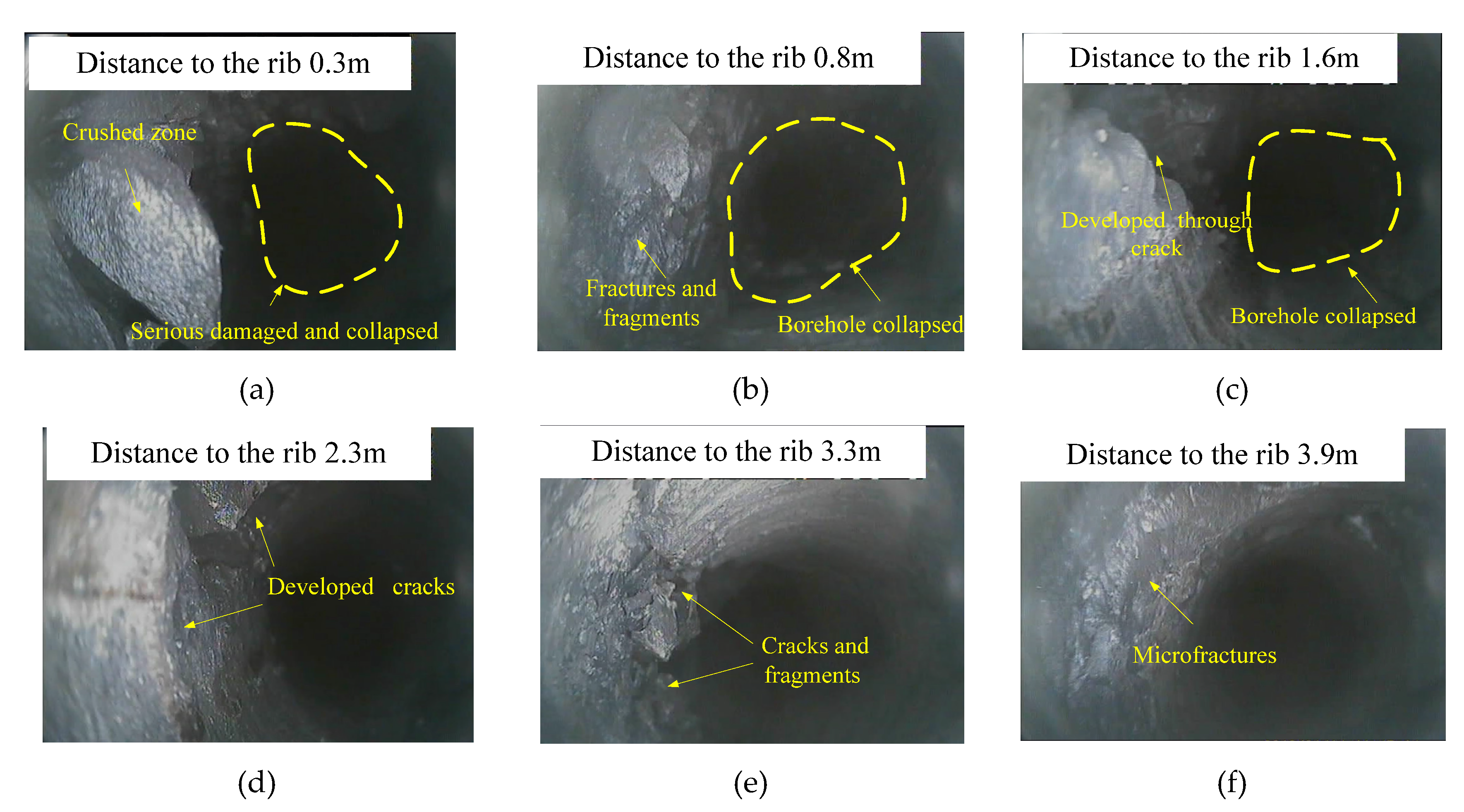
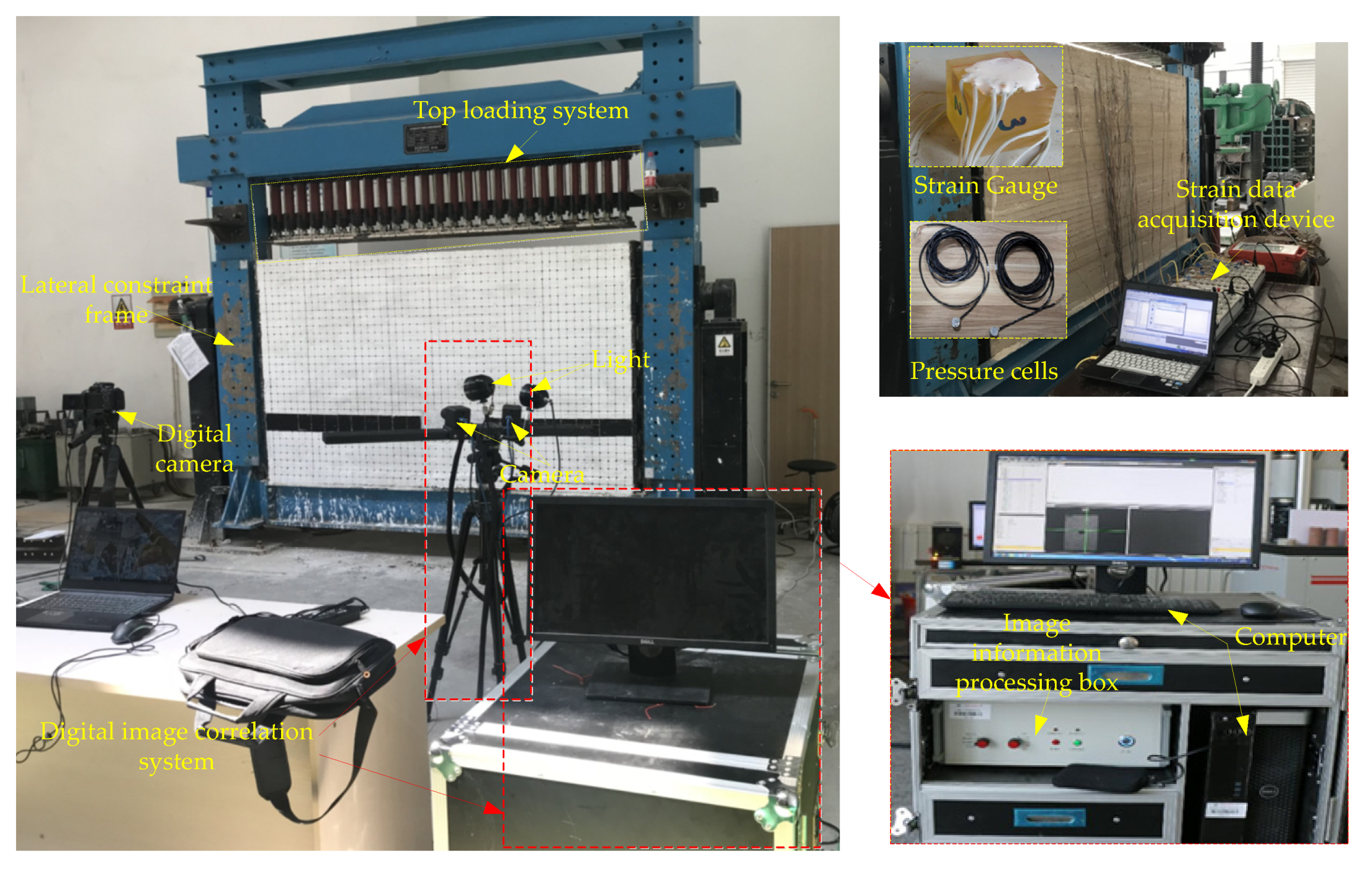
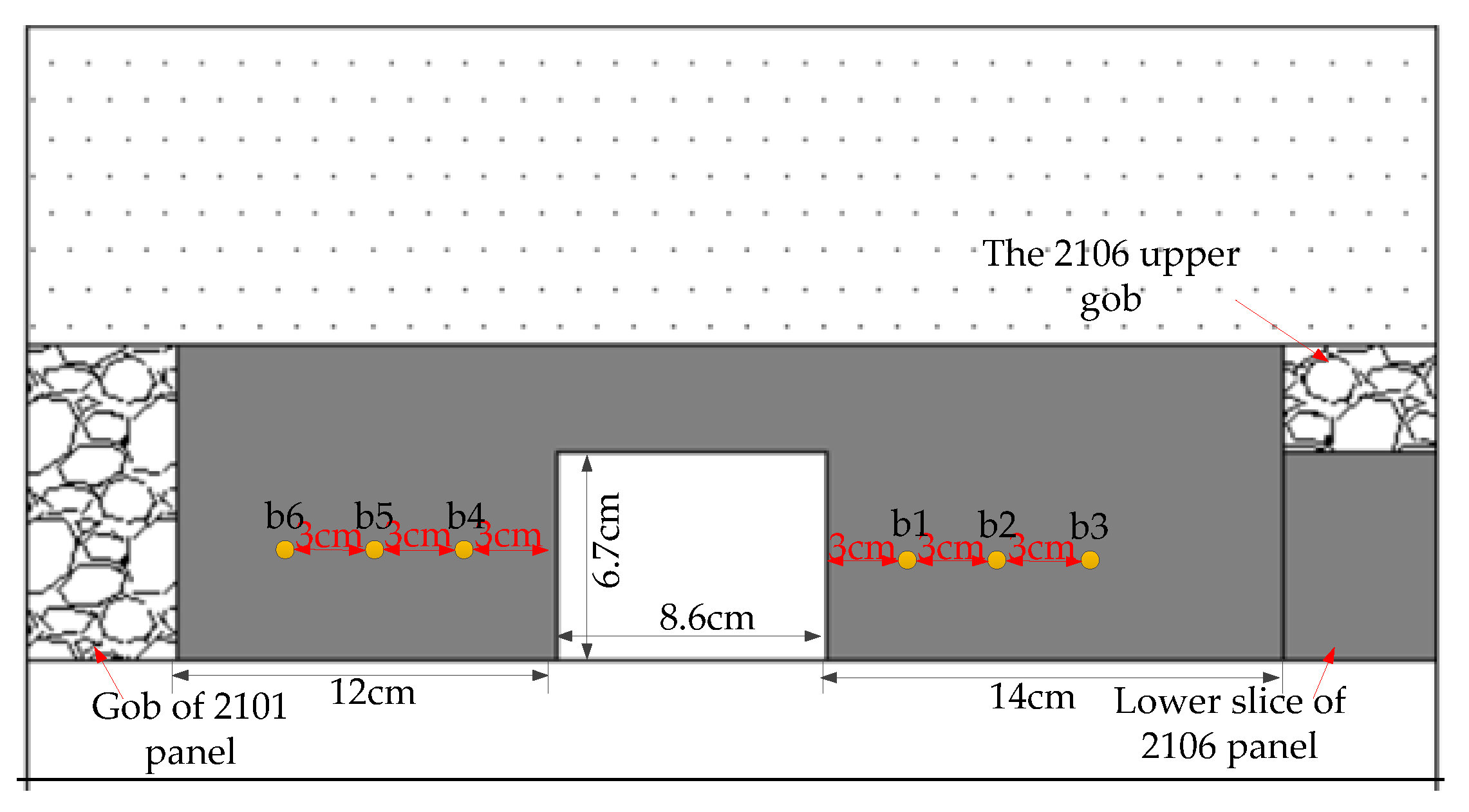
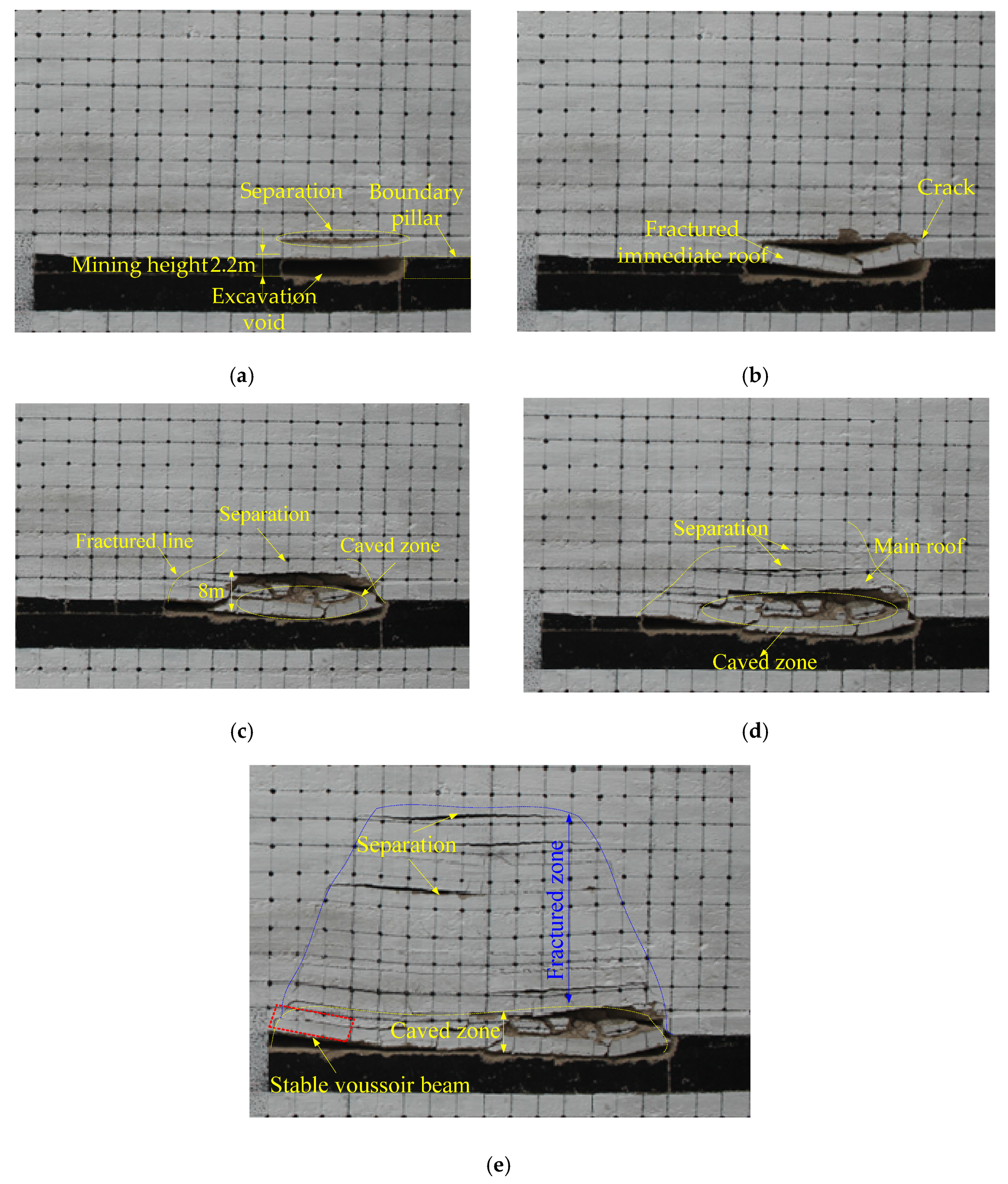
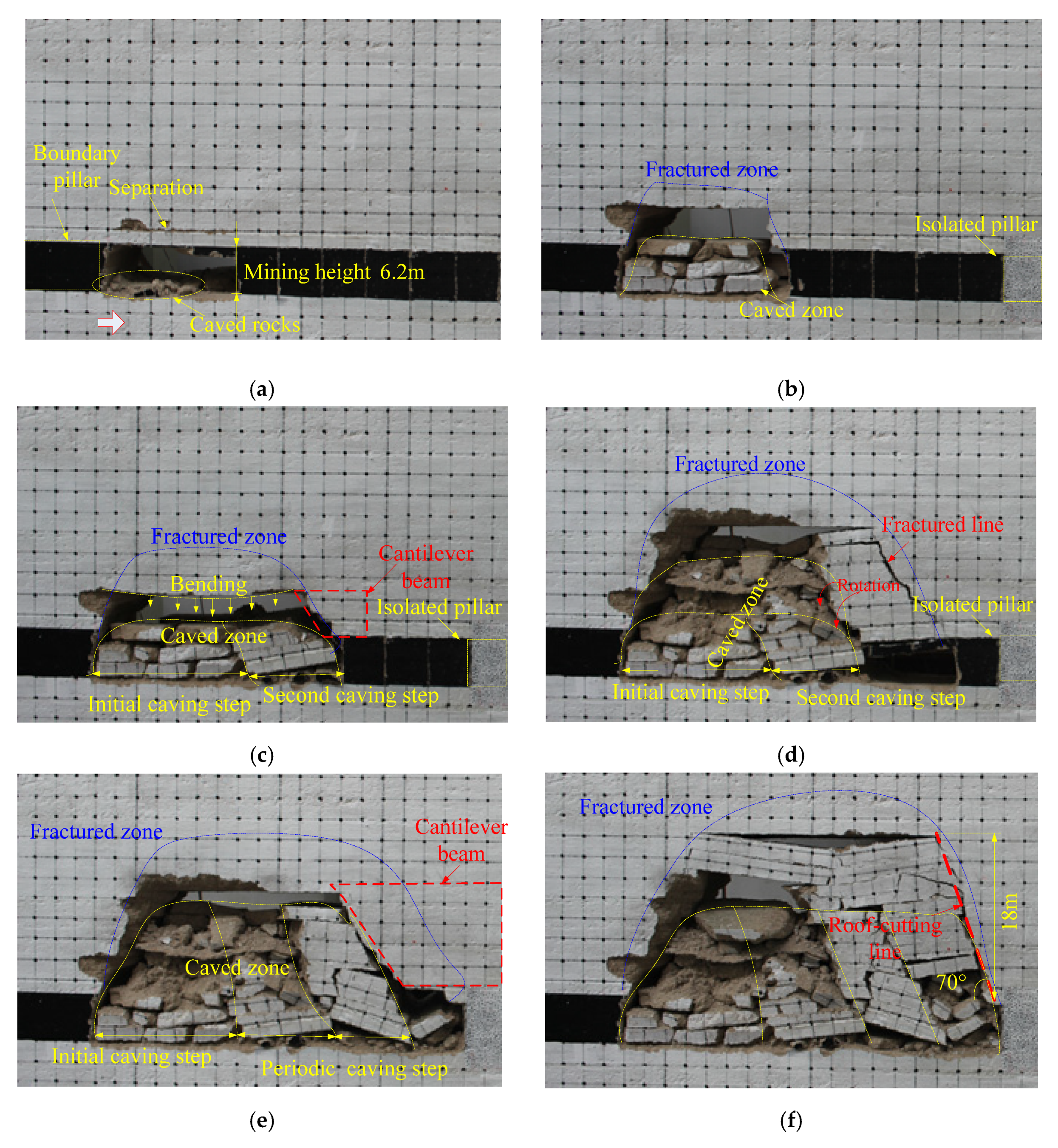
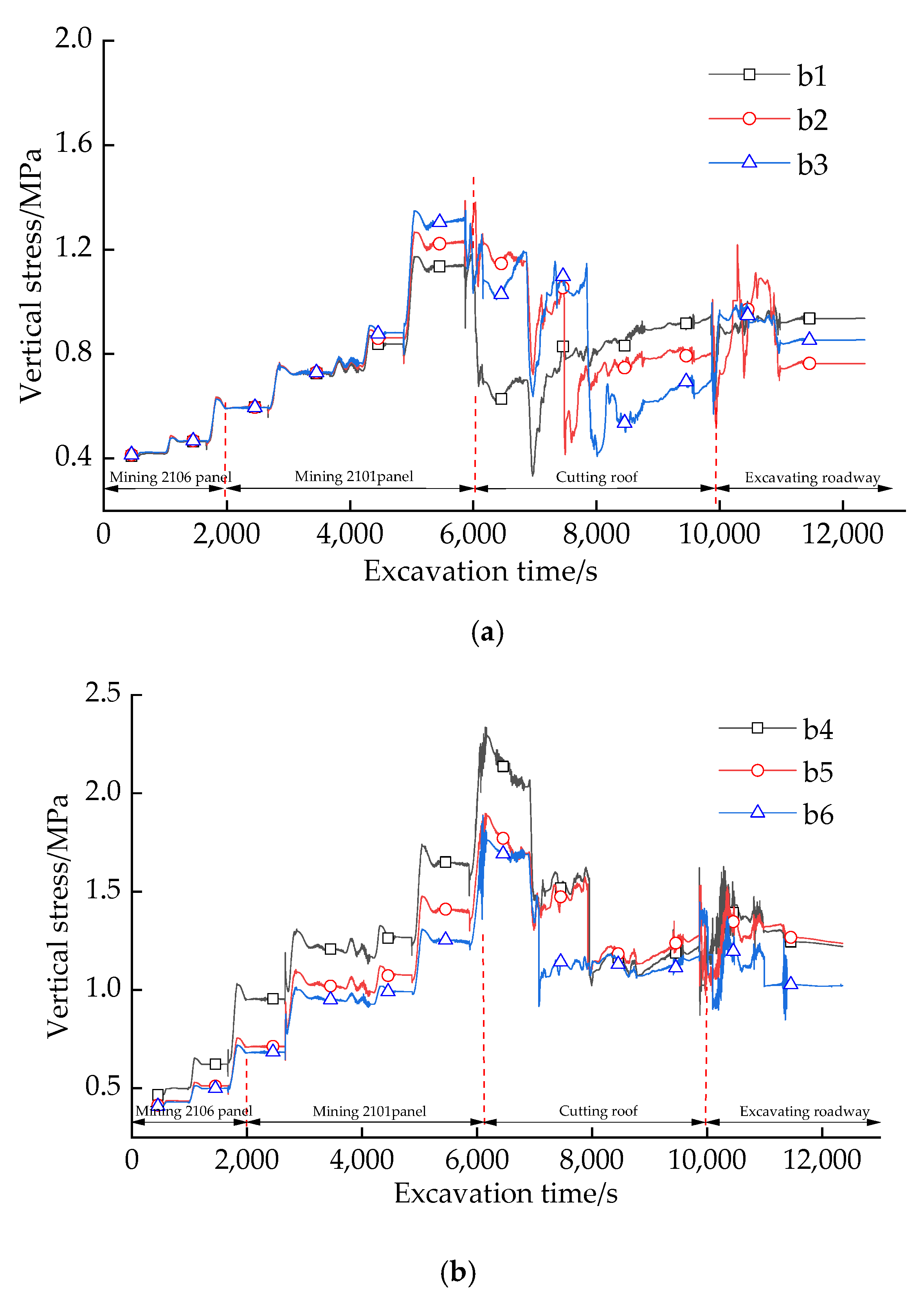
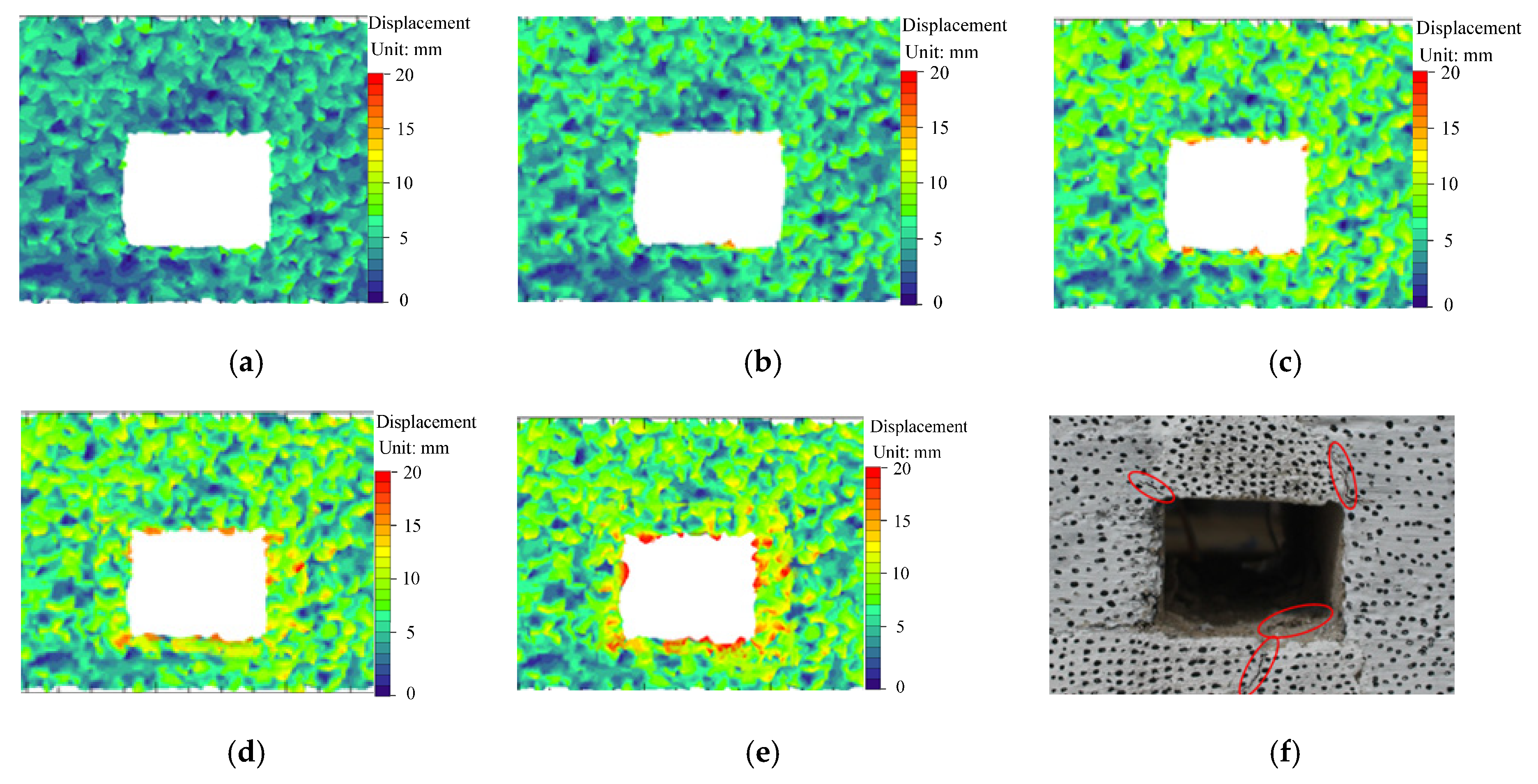

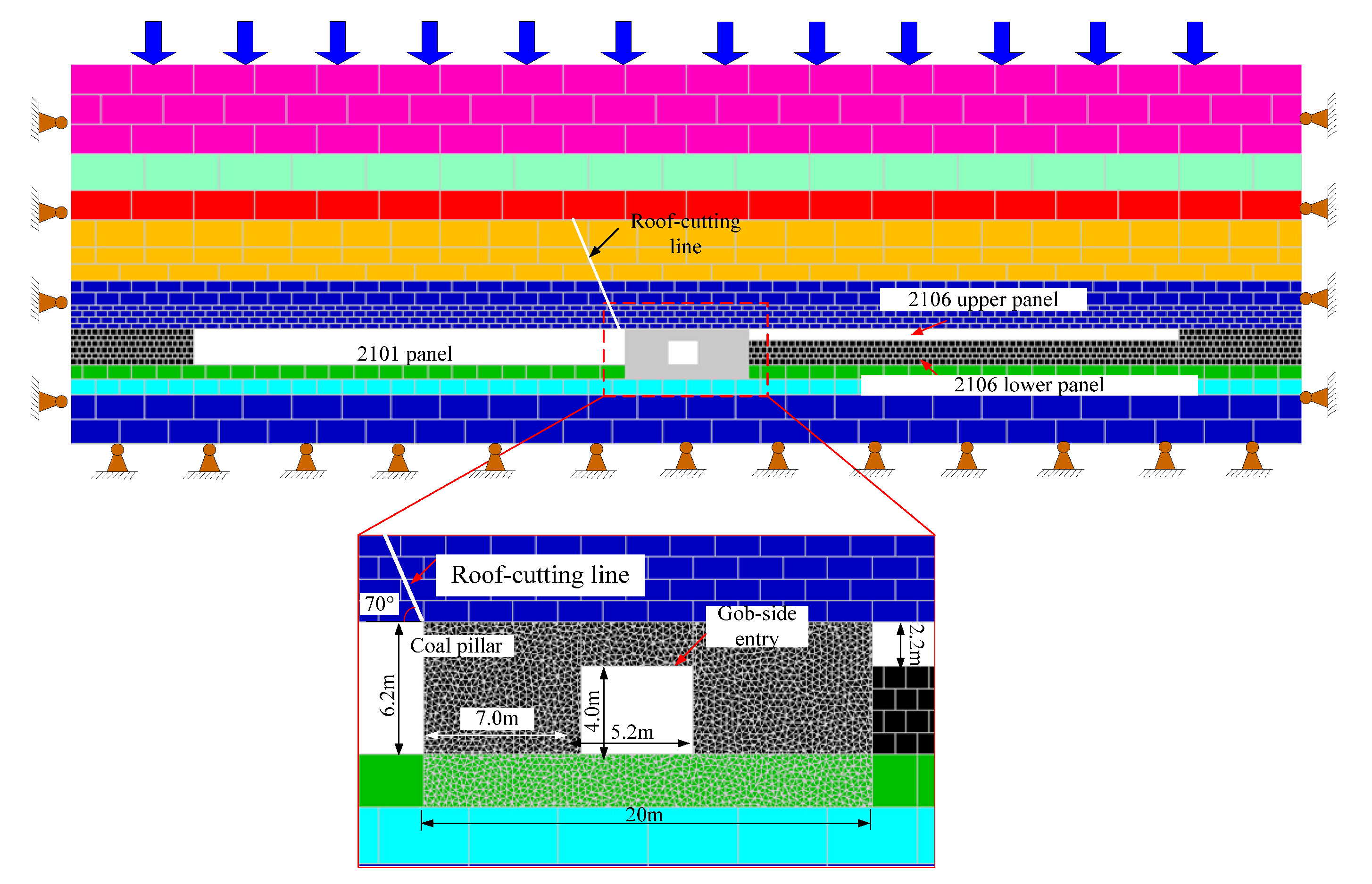

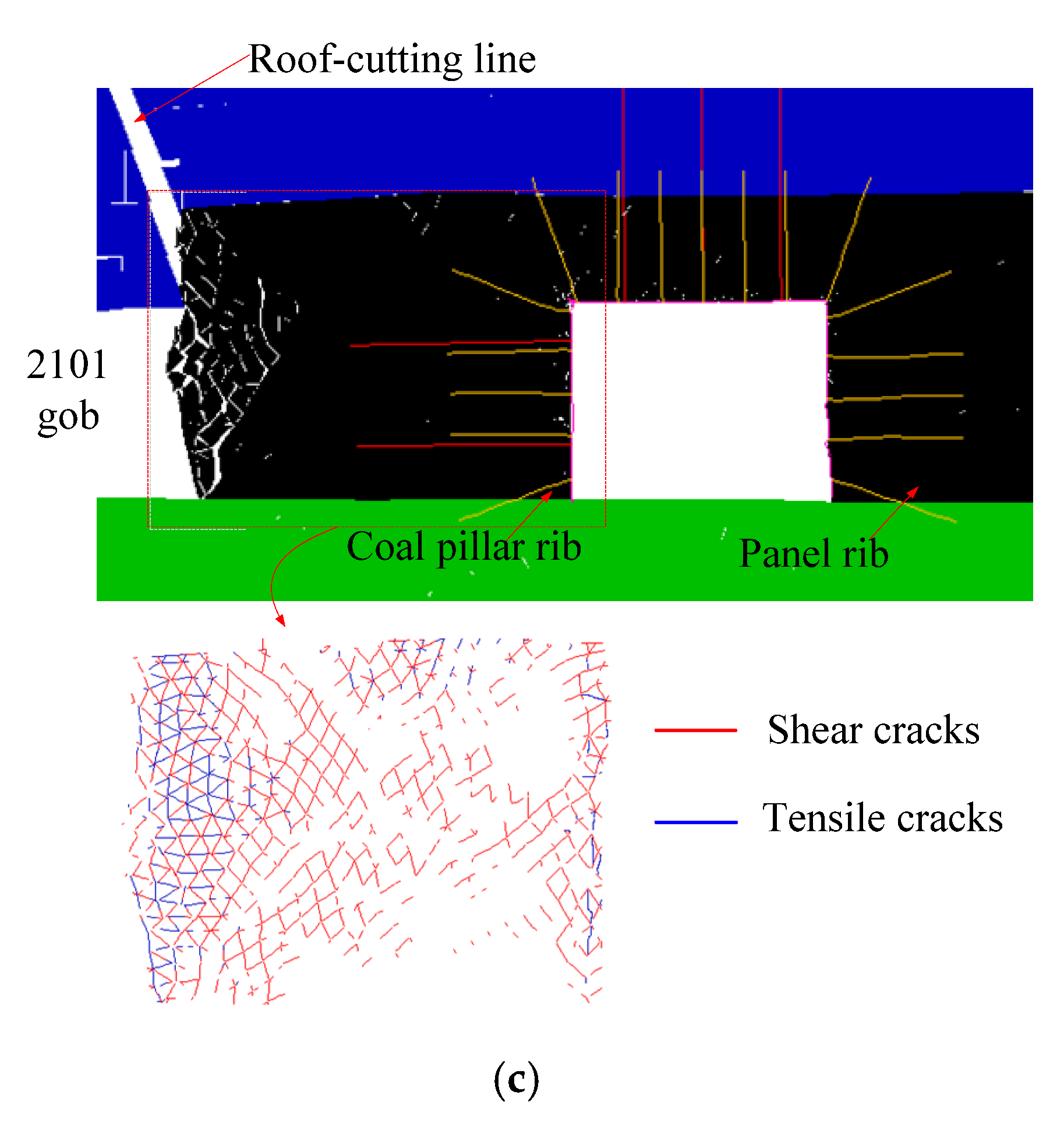
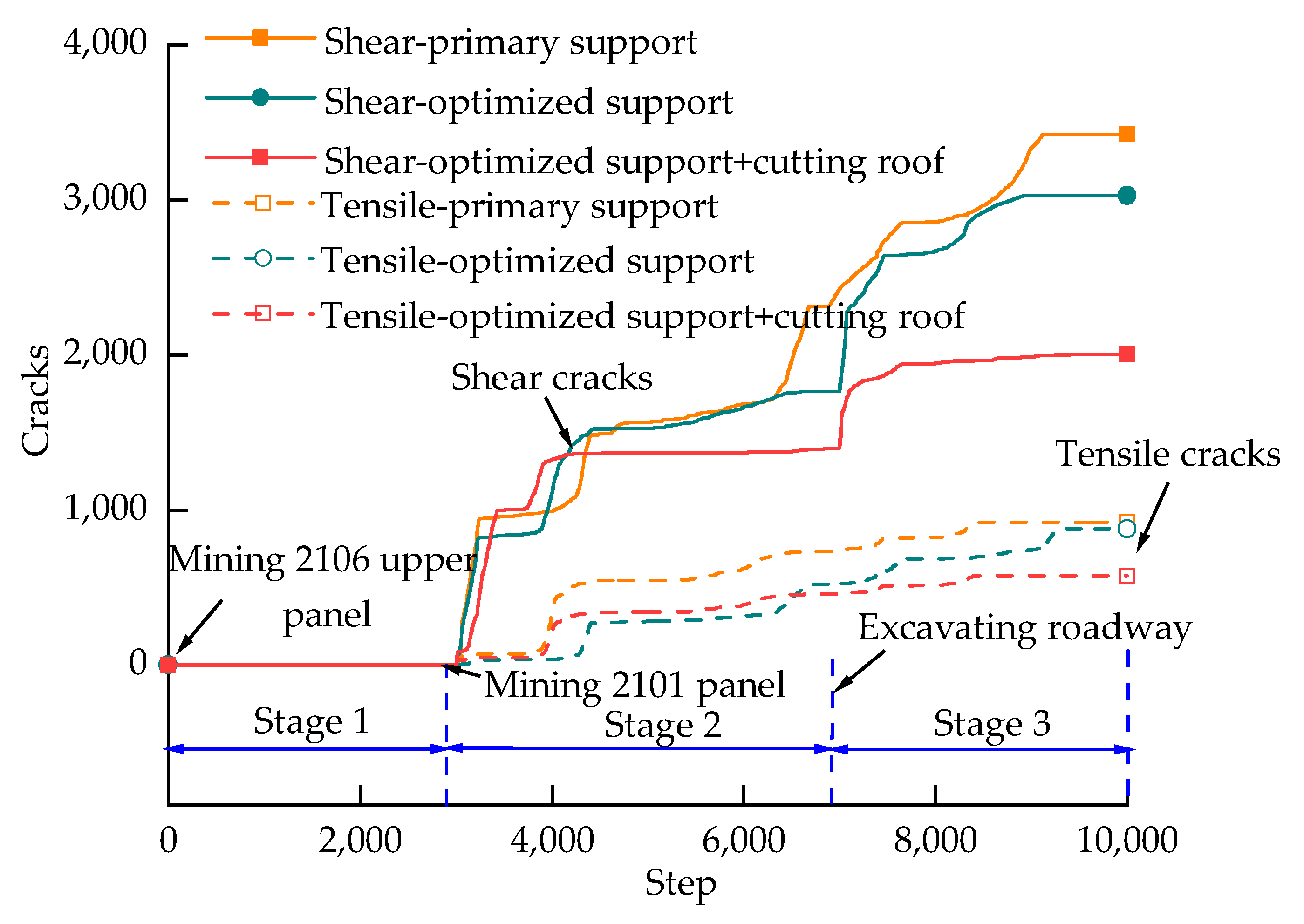
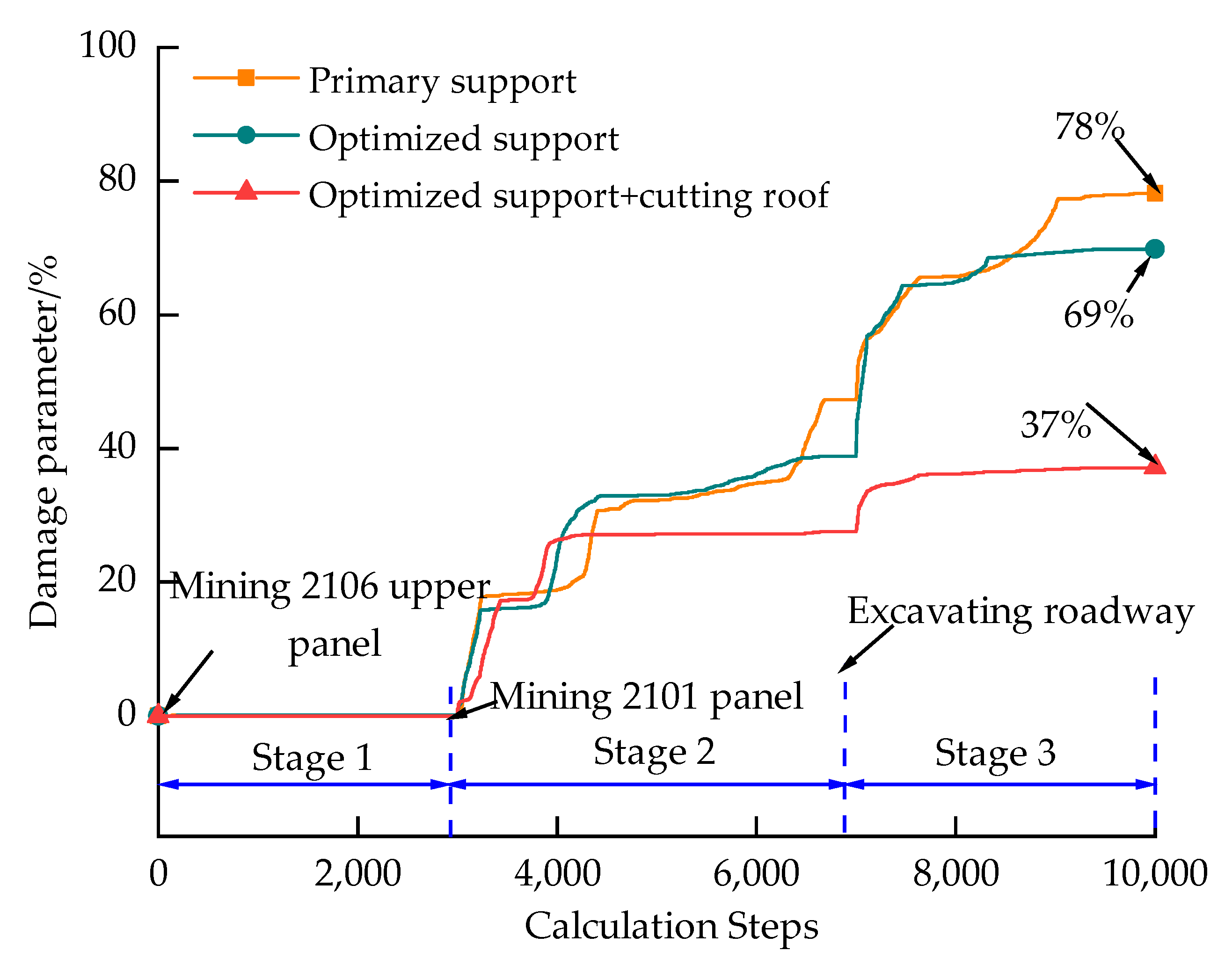
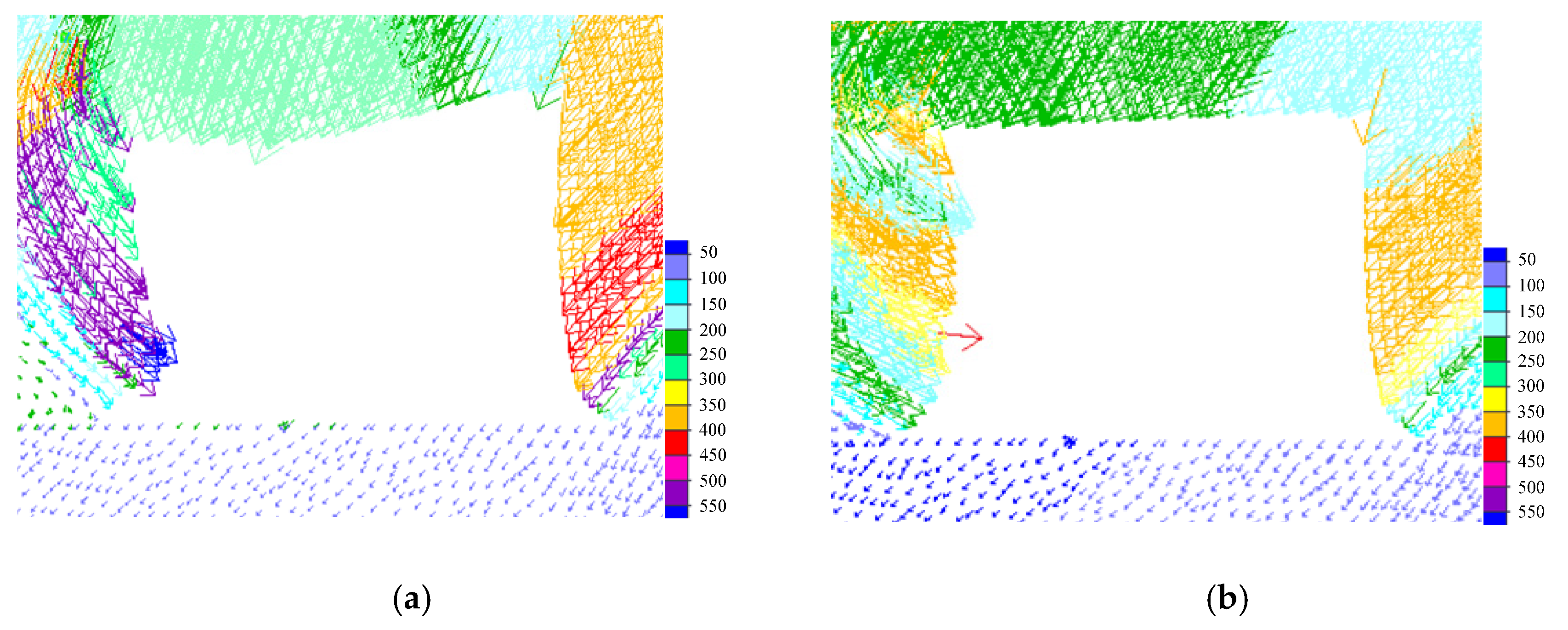
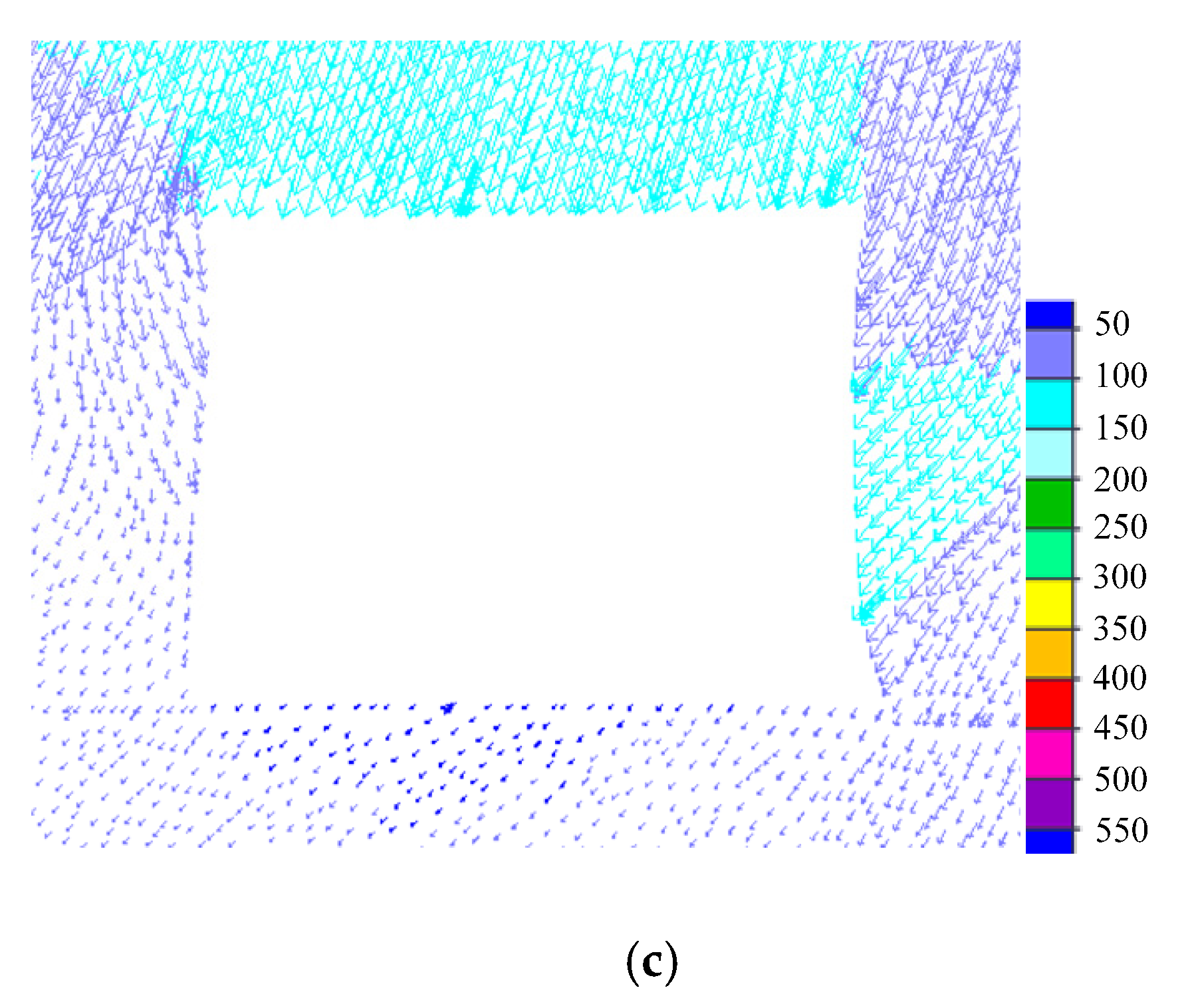
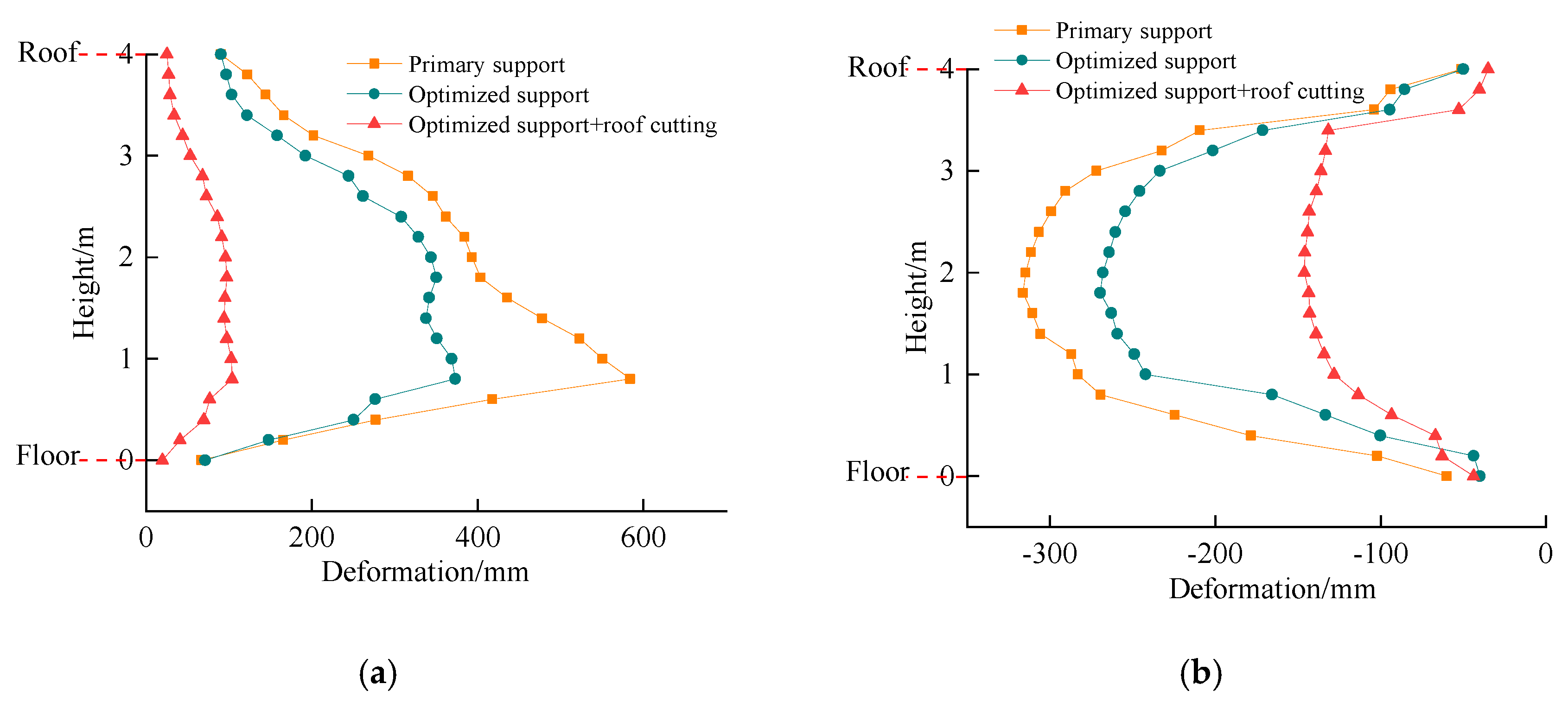
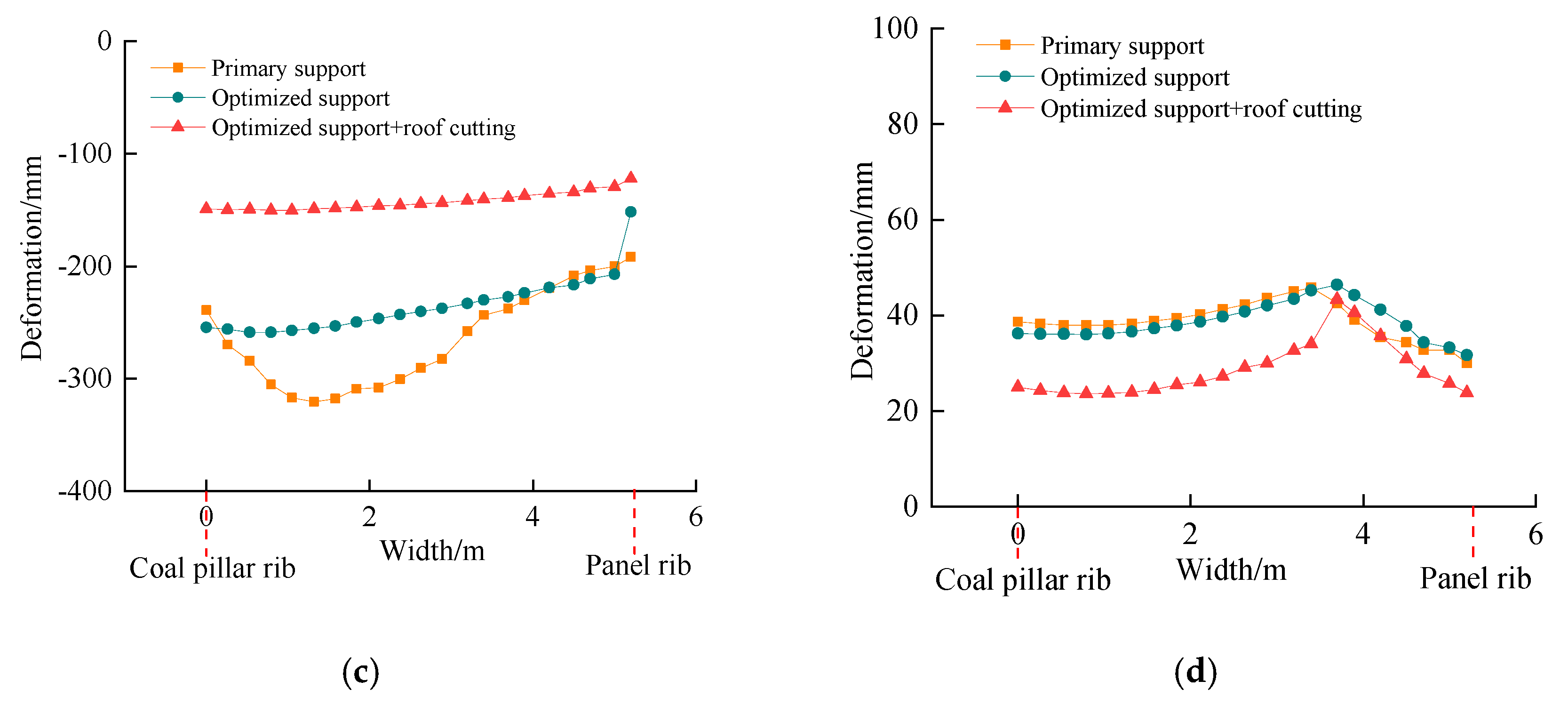
| Remarks | Name | Thickness | Symbol | Lithology Characterization |
|---|---|---|---|---|
| Main roof | Fine sandstone | 8.6 |  | Gray to dark gray, layered structure, hard and compact |
| Medium-fine Sandstone | 7.4 |  | Grey to grey white, siliceous cementation, hard | |
| Siltstone | 5.7 |  | Dark gray, soft, containing plant fossils and charcoal chips | |
| Immediate roof | Mudstone | 9.8 |  | Gray, muddy cementation, and crisp |
| 2# coal stratum | 6.2 |  | Black, shiny glass, endoge-netic fissure development | |
| Immediate floor | Slitstone | 5.4 |  | Dark gray, soft, containing plant fossils and charcoal chips |
| Lithology | Compressive Strength (MPa) | Elastic Modulus (GPa) | Materials Ratio (River-Sand: Calcium Carbonate: Gypsum) |
|---|---|---|---|
| Fine sandstone | 0.81 | 0.26 | 5:0.6:0.4 |
| Medium-fine sandstone | 0.52 | 0.16 | 4:0.5:0.5 |
| siltstone | 0.44 | 0.14 | 5:0.7:0.3 |
| Mudstone | 0.27 | 0.07 | 7:0.6:0.4 |
| Coal | 0.13 | 0.04 | 6:0.4:0.6 |
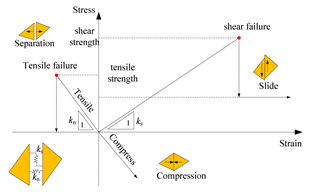 (a) The constitutive relation of micro contact | In the direction of perpendicular to the contacts, where Δσn represents the effective normal force increment, Δun and kn represent the normal displacement increment and normal stiffness, respectively. In the direction of parallel to the contacts, , Then , Or else, if , Then , where Δuse is the elastic shear displacement increment, Δus is the total shear displacement increment. (b) Coulomb friction law |
| Rock Strata | Intact Rock Samples | RQD | Rock Mass | ||
|---|---|---|---|---|---|
| Er (GPa) | σr (MPa) | Em (GPa) | σm(MPa) | ||
| Fine sandstone | 17.3 | 53.8 | 95 | 12.44 | 43.72 |
| Medium-fine sandstone | 10.8 | 34.6 | 92 | 6.83 | 25.93 |
| siltstone | 9.6 | 28.9 | 91 | 5.81 | 21.08 |
| Mudstone | 5.2 | 17.6 | 86 | 2.54 | 11.21 |
| Coal | 2.8 | 8.6 | 72 | 0.75 | 3.75 |
| Lithology | Block Properties | Contact Properties | ||||||
|---|---|---|---|---|---|---|---|---|
| Density (kg/m3) | K (GPa) | G (GPa) | kn (GPa/m) | ks (GPa/m) | Cj (MPa) | Φj (°) | σtj (MPa) | |
| Fine sandstone | 2030 | 8.62 | 4.91 | 35.40 | 14.04 | 4.18 | 24 | 2.26 |
| Medium-fine sandstone | 2560 | 4.72 | 2.69 | 29.12 | 11.55 | 2.64 | 22 | 1.33 |
| siltstone | 2720 | 4.02 | 2.30 | 24.83 | 9.85 | 1.75 | 20 | 1.52 |
| Mudstone | 1400 | 1.73 | 0.99 | 21.42 | 8.49 | 1.28 | 20 | 1.22 |
| Coal | 1800 | 0.51 | 0.33 | 25.20 | 10.08 | 1.08 | 16 | 0.44 |
| Properties | Elastic Modulus (GPa) | Tensile Yield Strength (kN) | Stiffness of the Grout (N/m2) | Cohesive Capacity of the Grout (N/m) | Compressive Yield Strength (MPa) | Interface Normal Stiffness (GPa/m) | Interface Shear Stiffness (GPa/m) |
|---|---|---|---|---|---|---|---|
| Bolt | 200 | 200 | 2 × 109 | 4 × 105 | -- | -- | -- |
| Cable | 200 | 390 | 2 × 109 | 4 × 105 | -- | -- | -- |
| Steel beam | 200 | 480 | -- | -- | 500 | 10 | 10 |
© 2020 by the authors. Licensee MDPI, Basel, Switzerland. This article is an open access article distributed under the terms and conditions of the Creative Commons Attribution (CC BY) license (http://creativecommons.org/licenses/by/4.0/).
Share and Cite
Shi, X.; Jing, H.; Zhao, Z.; Gao, Y.; Zhang, Y.; Bu, R. Physical Experiment and Numerical Modeling on the Failure Mechanism of Gob-Side Entry Driven in Thick Coal Seam. Energies 2020, 13, 5425. https://doi.org/10.3390/en13205425
Shi X, Jing H, Zhao Z, Gao Y, Zhang Y, Bu R. Physical Experiment and Numerical Modeling on the Failure Mechanism of Gob-Side Entry Driven in Thick Coal Seam. Energies. 2020; 13(20):5425. https://doi.org/10.3390/en13205425
Chicago/Turabian StyleShi, Xinshuai, Hongwen Jing, Zhenlong Zhao, Yuan Gao, Yuanchao Zhang, and Ruodi Bu. 2020. "Physical Experiment and Numerical Modeling on the Failure Mechanism of Gob-Side Entry Driven in Thick Coal Seam" Energies 13, no. 20: 5425. https://doi.org/10.3390/en13205425
APA StyleShi, X., Jing, H., Zhao, Z., Gao, Y., Zhang, Y., & Bu, R. (2020). Physical Experiment and Numerical Modeling on the Failure Mechanism of Gob-Side Entry Driven in Thick Coal Seam. Energies, 13(20), 5425. https://doi.org/10.3390/en13205425




